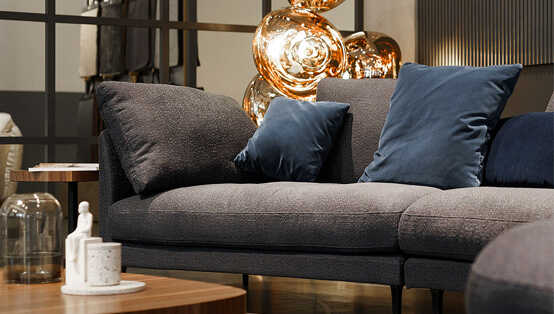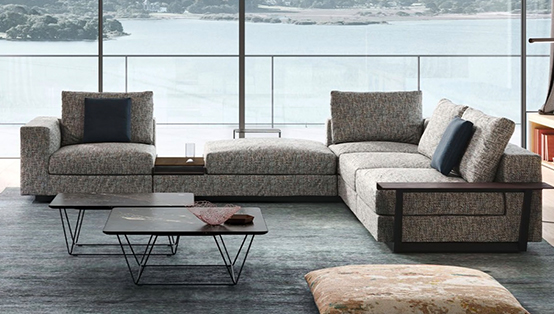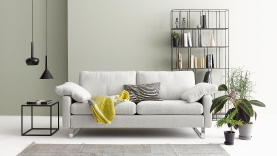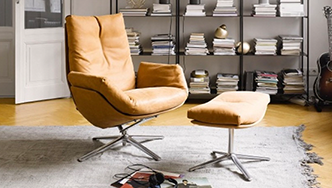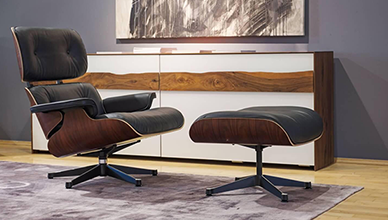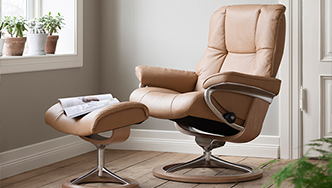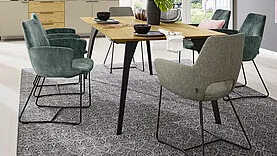Designer chair as a statement: art meets function
In the world of interior design, chairs are far more than just functional seating. They are an expression of style, creativity and personality. Designer chairs, especially in a carefully designed room, can make a strong statement and significantly shape the aesthetics.
Designer chairs: more than just seating furniture
In any living room, it is often the designer chairs that immediately catch the eye. They combine functionality with artistic design and transform an ordinary room into a stylish ambience. Current trends in the world of designer chairs include
Color accents: Vibrant colors are currently very popular. A designer chair in a bold blue, deep red or sunny yellow can serve as an impressive eye-catcher in an otherwise neutral room.
Mixed materials: The combination of different materials such as wood and metal or plastic and textile gives the chairs a unique texture and an exciting visual interest.
Organic shapes: Round and flowing shapes inspired by nature contrast with traditional, straightforward designs and bring a soft, calming aesthetic to the room.
Minimalism with a twist: Minimalist designs remain popular, but are enhanced by interesting details such as unusual leg shapes or unexpected textures.
Sustainability in design: More and more designer chairs are using ecological materials and sustainable production methods, which makes them not only visually appealing, but also ethically appealing.
The diversity of chair design
Chair design" is about much more than just form. It is the art of harmonizing material, function and aesthetics. Here are some remarkable shapes that can be found in the world of designer chairs:
Sculptural shapes: These chairs look like modern works of art. They are characterized by unconventional lines and curves that are often inspired by abstract art and immediately transform the room into an art gallery-like ambience.
Classic silhouettes: Inspired by historical designs, these chairs offer a timeless elegance. They are often in traditional shapes such as the Windsor or Chippendale style, but reinterpreted with modern materials and colors.
Geometric designs: Chairs with clear, geometric shapes such as rectangles, triangles and circles offer a minimalist yet eye-catching design. They fit perfectly into modern, urban spaces.
Organic and flowing shapes: Based on natural shapes, these chairs bring softness and movement to interior design. They are often inspired by elements of nature and fit harmoniously into rooms that radiate a calm and relaxing atmosphere.
Modular and transformable shapes: These innovative designs offer flexibility and functionality. They can adapt to different space requirements, for example by being pulled apart or put together.
The influence of designer chairs on space and mood
A carefully selected designer chair can change the mood of an entire room. This change happens in different ways:
Color and tone: A chair in a vibrant color can bring a touch of energy and cheerfulness to a room, while a chair in muted, earthy tones creates a calming and relaxing atmosphere.
Shape and structure: The shape of a chair can say a lot about the character of a room. A chair with soft, rounded shapes conveys coziness and comfort, while a chair with sharp, clean lines creates a more modern, structured atmosphere.
Material and texture: The choice of material for a chair can also influence the mood. A velvet chair can exude luxury and opulence, while a simple wooden chair creates a natural and earthy mood.
Style and design: The style of a chair - whether it is modern, retro, industrial or traditional - can shape the overall style of a room and therefore the way you feel in that room.
Positioning and arrangement: The way a chair is positioned in the room can also influence the mood. A single, prominently positioned chair can act as a focal point and draw attention to itself, while a group of chairs can be inviting and sociable.
Timeless chair design classics
In the world of furniture design, there are some chairs that are not only regarded as seating, but also as works of art. These classics have stood the test of time and are as relevant today as ever. Here are some of these timeless masterpieces:
S 64 / S 32 cantilever chair by Thonet: Designed by Marcel Breuer in 1928 and produced by Thonet since 1930, this chair embodies the elegance of the Bauhaus era. The combination of Viennese wickerwork and chrome-plated tubular steel gives it a striking silhouette that is popular in both offices and private dining areas.
Panton Chair by Vitra: This chair, designed by Verner Panton and produced by Vitra since 1967, is an icon of the 20th century. Its flowing form and flexibility make it a favorite for both indoor and outdoor areas.
AAC 22 About a Chair by Hay: The simple yet striking series from Danish label Hay, designed by Hee Welling, is characterized by its versatility and elegance. The chair is available in different versions and colors and adapts seamlessly to various environments.
Series 7 chair by Fritz Hansen: Designed in 1955 by Arne Jacobsen, this chair is a symbol of modern furniture design. Its unique shape is both elegant and characteristic and is available in various colors and finishes.
Plastic Side Chair by Vitra: Designed by the legendary designers Charles and Ray Eames, this chair has been a symbol of style and innovation since 1950. Its striking Eiffel Tower base and the versatility of the seat shell make it an enduring favorite.
In Between SK1 by &Tradition: This elegant and delicate-looking chair was designed by Sami Kallio for &Tradition. The large spaces in the backrest and the choice of different types of wood and upholstery colors make it a versatile and aesthetic piece.
Tulip chair by Knoll International: Designed by Eero Saarinen in 1957, this chair with its trumpet-shaped base and seamless seat shell is a design icon. Available with and without armrests, it fits perfectly into modern dining areas.
The Jeanneret Chair via Cassina: A masterpiece of modernist architecture, designed by Pierre Jeanneret for the Indian city of Chandigarh. This chair, with its characteristic teak frame and reed, is a coveted collector's item and a tribute to minimalist design.
Each of these chairs tells a story of innovation, creativity and timeless design. They are not only seating furniture, but also important components of design history that can transform any dining room or living room into a showroom.





